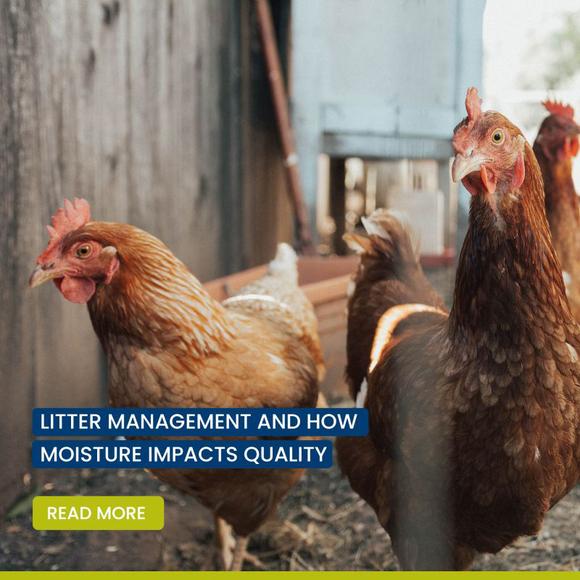Explore all the information on
Poultry litter
Poultry litter is the mix of bedding material, manure and feathers that result from intensive poultry production. This includes litter from meat chickens (broilers), egg-laying chickens (layers) kept under barn conditions, turkeys, ducks and quails. Poultry bedding material consists of wood shavings, pine straw, peanut hulls, and other absorbent dry low-cost materials and is another possible source of pathogenic contamination for poultry. It is generally recommended that farmers keep litter as dry as possible, replace the top layer of the litter with a new one, and apply acid-based litter amendments. Keeping litter dry is a critical part of overall management on every poultry farm. Litter conditions influence bird performance, which in turn affects profits of growers and integrators. Dry litter helps control ammonia levels, provides a healthy flock environment, and reduces condemnations due to hock and footpad burns and breast blisters.
Ryan Arsenault (University of Delaware) Significant research and development has been committed to finding alternatives to antibiotics that are at least as effective as conventional antibiotics in preventing disease and promoting growth. It has been well known for 70 years that antibiotics have this dual disease/growth effect. However, it was only around the turn of the century that consideration of antibiotic host effects on growth and immunity were...
Comments : 0
Recommendations: 0
Annelies Kers (Utrecht University) speaks on the relation between the gut microbiome of chickens and their environment, during the 11th Symposium on Gut Health in Production of Food Animals in St. Louis, USA....
Comments : 0
Recommendations: 0
Ryan Arsenault (University of Delaware) talks about immunometabolism and takes a look at feed additives such as postbiotics and butyrate, during the 11th Symposium on Gut Health in Production of Food Animals in St. Louis, USA....
Comments : 0
Recommendations: 1
DESCRIPTION OF PROBLEM Avian coccidial disease, endemic across worldwide broiler production, and can be exacerbated by the reuse of litter should oocysts shed from previous flocks build up and sporulate in the current flock. Coccidial species can infect the gastrointestinal tract from the duodenum to the ceca resulting in localized tissue damage and reduced performance and without treatment, potentially result in morbidity and mortality (Chapman, 2014). The morbidity and mortality...
Comments : 0
Recommendations: 2
1. Introduction Air emissions from concentrated animal feeding operations (CAFOs), are reported to cause health impacts for both the animals and humans exposed [1–3]. The concentration of fine particulate matter (PM 2.5 ) and gases emitted from CAFOs can have regional impacts on people living in the area around them [3–7]. More recent studies show that emissions from agricultural facilities can cause the nitrogen enrichment of soils and waterways [8]. While...
Comments : 0
Recommendations: 0
1. Introduction Animal welfare is a fundamental component of sustainability, agricultural development and food security. In order for a livestock system to be sustainable, it should be sustainable economically, environmentally and ecologically, and at the same time, it should be accepted ethically and socially [1–3]. Today, a product of animal origin is not considered sustainable unless the social demand for welfare of the production animals is satisfied [1]. Animal...
Comments : 0
Recommendations: 0


Enhancing Egg Production: Key Factors Influencing Chicken Health and Yield
Suggested link
Watery and sticky droppings in layers have been a problem in the egg industry for years. Wet droppings or diarrhea in chickens are early indicators of intestinal distress and can give a producer crucial information about the general gut health of their flock. Poultry litter becomes wet when the rate of water addition exceeds the rate of removal. Poor quality ingredients, toxins, pathogens and nutrient imbalances can cause wet litter directly by altering normal digestive physiology or...
Comments : 1
Recommendations: 1
Hi there, Does anyone have any experience with the use of sodium bentonite in layer diets as a means to dry wet litter? There seem to be conflicting answers based on the role sodium plays in drawing out moisture. Thanks, ...
Comments : 0
Recommendations: 0
Connie Mou (University of Georgia) commented on humidity, air movement and dry litter in poultry houses, during IPPE 2020 in Atlanta, USA....
Comments : 7
Recommendations: 5
Effective litter management is crucial for optimal animal nutrition. Proper litter management practices ensure a clean and healthy environment for animals, reducing the risk of contamination and disease. By maintaining clean and dry litter, we promote better hygiene, minimize bacterial growth, and enhance feed safety....
Comments : 0
Recommendations: 0


Feed Granulometry and the Importance of Feed Particle Size in Layers
Suggested link
...
Comments : 0
Recommendations: 0
Tom Tabler (The University of Tennessee) discusses how to manage poultry litter and effectively use ventilation to avoid health and welfare issues, in this interview during IPPE 2023 in Atlanta, USA....
Comments : 1
Recommendations: 0
Background & Objectives There has been immense growth in the global poultry industry that should be maintained to match the current preference of consumers for animal protein. Such growth also calls for a better understanding of factors that could influence production such as litter. Ducks spend their entire rearing period in contact with the litter material provided. It is therefore vital to investigate the effect that the different commercially available bedding materials...
Comments : 0
Recommendations: 0
When placing chicks it is crucial to their future performance and health to make sure the litter they are placed upon has been thoroughly warmed. Though the air in a house can be heated relatively quickly, insuring the litter throughout a brooding area is heated to between 85°F and 95°F can take from 12 and 36 hours depending on the type of heating system, level of air movement, house tightness, litter moisture level, etc. Since the chicks are in constant contact with the litter,...
Comments : 0
Recommendations: 0
.jpg&w=3840&q=75)

Afla V ONE 5 - 300 ppb Method for Total Aflatoxin Detection in Complete Feeds and Pet Food
Suggested link
Mike Czarick (University of Georgia) explains how this application can help you assess how much you need to ventilate your poultry house, in this interview during IPPE 2023 in Atlanta, USA....
Comments : 0
Recommendations: 1
Vijay Durairaj (Huvepharma) explains the severity of this disease, and comments on diagnosis and prevention best practices, in this interview during IPPE 2023 in Atlanta, USA....
Comments : 0
Recommendations: 1
1. Introduction The occurrence of ‘wet litter’ in meat chicken sheds is associated with concerns regarding animal welfare, flock health, food safety, environmental impacts and reductions in production efficiency. Mitigating wet litter will only be achieved when there is thorough understanding of the multidimensional causal factors. This will require a multidisciplinary approach to understand the hydrology in the meat chicken shed micro-environment; the biological...
Comments : 0
Recommendations: 1
Background & Objectives Bedding materials and depth of beddings are vital elements for litter management, which could directly or indirectly alter the growth performance of poultry. In the poultry industry, duck meat is the second most widespread poultry sector in the world after chicken meat, and Pekin ducks have become the most efficient broiler duck type popular in the Asian region. This study aimed to investigate the appropriate depth of bedding material (rice husk) for...
Comments : 0
Recommendations: 0
INTRODUCTION During the last decade, the decrease in sequencing costs coupled with innovations in computational technologies (1) has remarkably advanced our understanding of the composition and function of microbial communities residing in diverse environments (2). Accordingly, the roles of microbiota in health and diseases have been well-documented in wide range of animals, yet limited microbiota studies have been conducted so far in turkeys. One study investigated the...
Comments : 0
Recommendations: 0


.jpg&w=3840&q=75)


00167-168.jpg&w=3840&q=75)



.jpg&w=3840&q=75)
















.jpg&w=3840&q=75)











